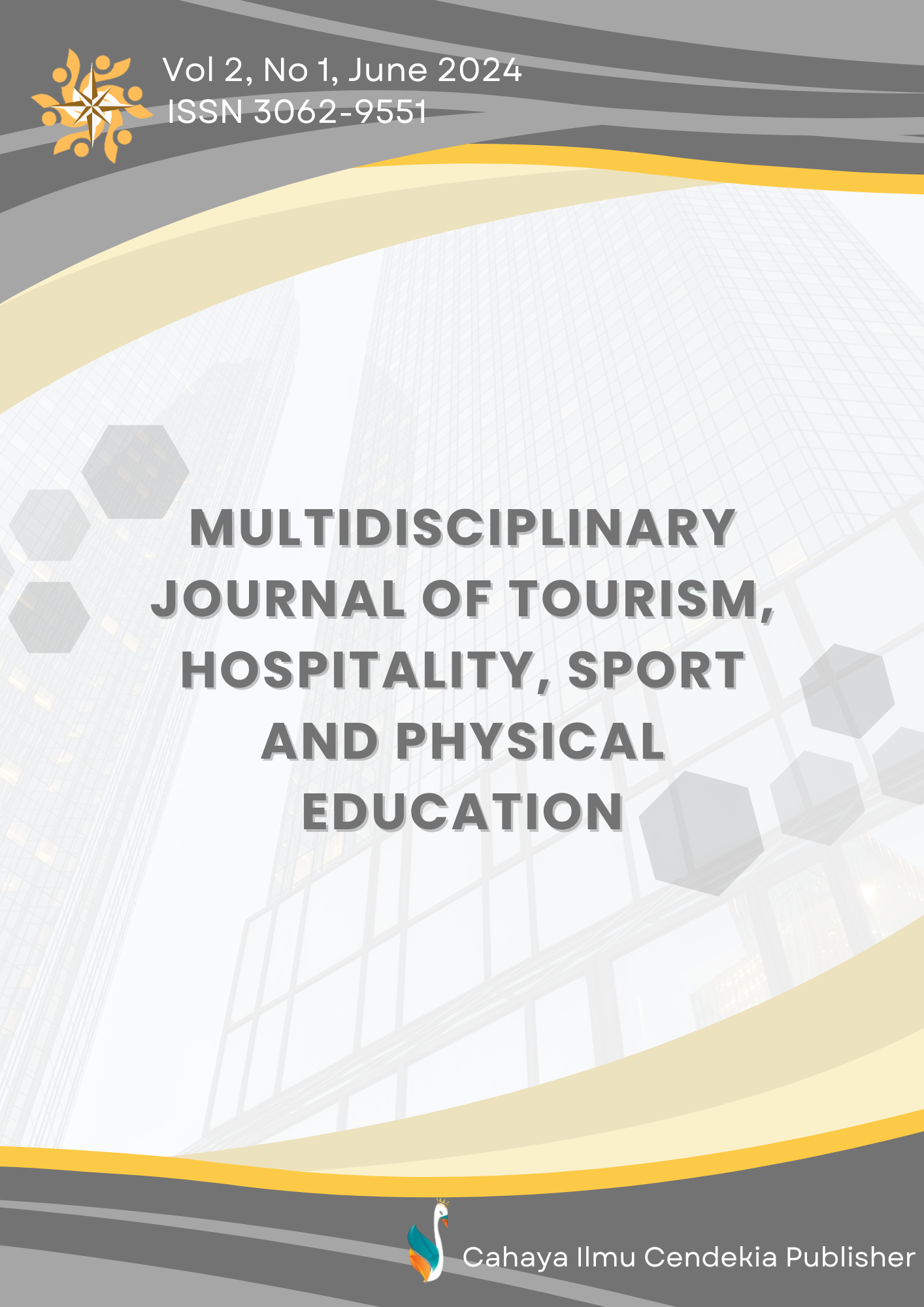Cultural Heritage Tourism And Sustainable Tourism Development Strategy In Morotai Island District
Abstract
Purpose of the study: This study aims to analyze the opportunities for developing cultural heritage tourism based on sustainable tourism models in Pulau Morotai District.
Methodology: This study used a qualitative descriptive method. Data were collected through field research, interviews with government stakeholders in Pulau Morotai, and documentation from relevant reports, books, journals, and articles. Data analysis applied qualitative techniques to examine sustainable tourism indicators based on the WCAD framework.
Main Findings: Pulau Morotai has significant potential to develop sustainable cultural heritage tourism due to its historical legacy, such as World War II sites and cultural landmarks. However, challenges include the limited involvement of local communities and NGOs, and overdependence on government and foreign investors. Improvement in stakeholder participation, infrastructure, and promotion strategies are needed to realize this potential.
Novelty/Originality of this study: This study contributes original insights into how a remote district like Pulau Morotai can utilize its cultural heritage as a strategic asset for sustainable tourism development. It highlights specific sustainability indicators and local governance dynamics that are rarely addressed in existing literature on Indonesian tourism planning.
References
C. Yasir, Yohannes, Andri, “Penta helix communication model through community based tourism (cbt) for tourism village development in koto sentajo, Riau, Indonesia,” Geoj. Tour. Geosites, vol. 37, no. 3, pp. 851–860, 2021, doi: 10.30892/gtg.37316-718.
M. Musleh, A. Subianto, M. H. Tamrin, and M. R. Bustami, “The role of institutional design and enabling environmental: collaborative governance of a pilgrimage tourism, Indonesia,” J. Local Gov. Issues, vol. 6, no. 1, pp. 75–90, 2023, doi: 10.22219/logos.v6i1.22218.
A. Littleton and K. Guskiewicz, “Current concepts in sport concussion management: A multifaceted approach,” J. Sport Heal. Sci., vol. 2, no. 4, pp. 227–235, 2013, doi: 10.1016/j.jshs.2013.04.003.
L. Fertas, M. Alouat, and H. Benmahamed, “Thermal tourism as a river of local development, an llustration of opportunities and constraints. case study of hammam-guergour in the province of sétif, Algeria,” Geoj. Tour. Geosites, vol. 40, no. 1, pp. 136–143, 2022, doi: 10.30892/GTG.40116-812.
J. P. Mihalik, R. C. Lynall, E. F. Teel, and K. A. Carneiro, “Concussion management in soccer,” J. Sport Heal. Sci., vol. 3, no. 4, pp. 307–313, 2014, doi: 10.1016/j.jshs.2014.07.005.
L. Muliani and I. Krisnawati, “Development model of special interest tourism packages through the exploration of local wisdom in desa wisata Wates Jaya,” J. Gastron. Tour., vol. 9, no. 2, pp. 56–67, 2022, doi: 10.17509/gastur.v9i2.52212.
O. El-Said and H. Aziz, “Virtual tours a means to an End: An analysis of virtual tours’ role in tourism recovery post COVID-19,” J. Travel Res., vol. 61, no. 3, pp. 528–548, 2022, doi: 10.1177/0047287521997567.
A. Timm et al., “Promoting men’s health through sports clubs: A systematic rapid realist review,” J. Sport Heal. Sci., vol. 14, p. 100969, 2024, doi: 10.1016/j.jshs.2024.100969.
A. Litheko, “Small tourism business growth through eco-tourism in mahikeng, South Africa,” African J. Hosp. Tour. Leis., vol. 10, no. 1, pp. 256–269, 2021, doi: 10.46222/AJHTL.19770720-83.
F. Nawir, N. Alam, T. Indrajaya, and I. Kusumawati, “Tourism promotion and services strategies to increase the number of visitors during the Covid-19 pandemic,” Int. J. Econ. Educ. Entrep., vol. 2, no. 1, pp. 233–245, 2022, doi: 10.53067/ije3.v2i1.61.
L. M. Schwab Reese, R. Pittsinger, and J. Yang, “Effectiveness of psychological intervention following sport injury,” J. Sport Heal. Sci., vol. 1, no. 2, pp. 71–79, 2012, doi: 10.1016/j.jshs.2012.06.003.
H. Liu, W. E. Garrett, C. T. Moorman, and B. Yu, “Injury rate, mechanism, and risk factors of hamstring strain injuries in sports: A review of the literature,” J. Sport Heal. Sci., vol. 1, no. 2, pp. 92–101, 2012, doi: 10.1016/j.jshs.2012.07.003.
M. Lochbaum and J. Gottardy, “A meta-analytic review of the approach-avoidance achievement goals and performance relationships in the sport psychology literature,” J. Sport Heal. Sci., vol. 4, no. 2, pp. 164–173, 2015, doi: 10.1016/j.jshs.2013.12.004.
R. Li, “Why women see differently from the way men see? A review of sex differences in cognition and sports,” J. Sport Heal. Sci., vol. 3, no. 3, pp. 155–162, 2014, doi: 10.1016/j.jshs.2014.03.012.
M. Lochbaum, J. Jean-Noel, C. Pinar, and T. Gilson, “A meta-analytic review of Elliot’s (1999) hierarchical model of approach and avoidance motivation in the sport, physical activity, and physical education literature,” J. Sport Heal. Sci., vol. 6, no. 1, pp. 68–80, 2017, doi: 10.1016/j.jshs.2015.07.008.
G. Sjøgaard et al., “Exercise is more than medicine: The working age population’s well-being and productivity,” J. Sport Heal. Sci., vol. 5, no. 2, pp. 159–165, 2016, doi: 10.1016/j.jshs.2016.04.004.
Y. Guo, H. Shi, D. Yu, and P. Qiu, “Health benefits of traditional Chinese sports and physical activity for older adults: A systematic review of evidence,” J. Sport Heal. Sci., vol. 5, no. 3, pp. 270–280, 2016, doi: 10.1016/j.jshs.2016.07.002.
L. N. Erickson and M. A. Sherry, “Rehabilitation and return to sport after hamstring strain injury,” J. Sport Heal. Sci., vol. 6, no. 3, pp. 262–270, 2017, doi: 10.1016/j.jshs.2017.04.001.
M. Caru, A. Levesque, F. Lalonde, and D. Curnier, “An overview of ischemic preconditioning in exercise performance: A systematic review,” J. Sport Heal. Sci., vol. 8, no. 4, pp. 355–369, 2019, doi: 10.1016/j.jshs.2019.01.008.
B. J. Stenner, J. D. Buckley, and A. D. Mosewich, “Reasons why older adults play sport: A systematic review,” J. Sport Heal. Sci., vol. 9, no. 6, pp. 530–541, 2020, doi: 10.1016/j.jshs.2019.11.003.
C. Towlson et al., “Maturity-associated considerations for training load, injury risk, and physical performance in youth soccer: One size does not fit all,” J. Sport Heal. Sci., vol. 10, no. 4, pp. 403–412, 2021, doi: 10.1016/j.jshs.2020.09.003.
J. Pérez-Gómez, J. C. Adsuar, P. E. Alcaraz, and J. Carlos-Vivas, “Physical exercises for preventing injuries among adult male football players: A systematic review,” J. Sport Heal. Sci., vol. 11, no. 1, pp. 115–122, 2022, doi: 10.1016/j.jshs.2020.11.003.
A. Zech et al., “Sex differences in injury rates in team-sport athletes: A systematic review and meta-regression analysis,” J. Sport Heal. Sci., vol. 11, no. 1, pp. 104–114, 2022, doi: 10.1016/j.jshs.2021.04.003.
J. van Ierssel, K. F. Pennock, M. Sampson, R. Zemek, and J. G. Caron, “Which psychosocial factors are associated with return to sport following concussion? A systematic review,” J. Sport Heal. Sci., vol. 11, no. 4, pp. 438–449, 2022, doi: 10.1016/j.jshs.2022.01.001.
A. Konrad et al., “Chronic effects of stretching on range of motion with consideration of potential moderating variables: A systematic review with meta-analysis,” J. Sport Heal. Sci., vol. 13, no. 2, pp. 186–194, 2024, doi: 10.1016/j.jshs.2023.06.002.
S. Faggian et al., “Sport climbing performance determinants and functional testing methods: A systematic review,” J. Sport Heal. Sci., vol. 14, p. 100974, 2024, doi: 10.1016/j.jshs.2024.100974.
J. M. Schulz, L. Pohlod, S. Myers, J. Chung, and J. S. Thornton, “Are female athlete specific health considerations being assessed and addressed in preparticipation examinations? A scoping review and proposed framework,” J. Sport Heal. Sci., vol. 14, p. 100981, 2024, doi: 10.1016/j.jshs.2024.100981.
H. L. R. Souza et al., “Does ischemic preconditioning enhance sports performance more than placebo or no intervention? A systematic review with meta-analysis,” J. Sport Heal. Sci., vol. 14, 2025, doi: 10.1016/j.jshs.2024.101010.
D. Jochum et al., “The merit of superimposed vibration for flexibility and passive stiffness: A systematic review with multilevel meta-analysis,” J. Sport Heal. Sci., vol. 14, 2025, doi: 10.1016/j.jshs.2025.101033.
J. H. Kim, K. Lee, and Y. Kim, “Ethical implications of artificial intelligence in marketing: A systematic literature review,” J. Bus. Res., vol. 134, pp. 722–735, 2021, doi: 10.1016/j.jshs.2025.101047.
R. R. Krishnan, “A knowledge network for a dynamic taxonomy of psychiatric disease,” Dialogues Clin. Neurosci., vol. 17, no. 1, pp. 79–87, 2015, doi: 10.31887/dcns.2015.17.1/rkrishnan.
H. von Kürthy, K. Aranda, G. Sadlo, and G. Stew, “Embroidering as a transformative occupation,” J. Occup. Sci., vol. 30, no. 4, pp. 647–660, 2023, doi: 10.1080/14427591.2022.2104349.
D. A. Adeniyi and M. F. Dinbabo, “Efficiency, food security and differentiation in small-scale irrigation agriculture: Evidence from North west Nigeria,” Cogent Soc. Sci., vol. 6, no. 1, 2020, doi: 10.1080/23311886.2020.1749508.
I. N. A. S. I Wayan pantiyasa, Moh Agus Sutiarso, “Evaluation of agriculture-based tourism products in tinggan traditional village,” J. Ilm. Ilmu Terap. Univ. Jambi, vol. 08, no. 1, pp. 5–10, 2023, doi: 10.22437/jiituj.v7i1.17795.
V. Filimonau and D. De Coteau, “Tourism resilience in the context of integrated destination and disaster management (DM2),” Int. J. Tour. Res., vol. 22, no. 2, pp. 202–222, 2020, doi: 10.1002/jtr.2329.
I. W. T. K. Pristiwasa and N. S. Br.Ht.Gaol, “Public and tourist perceptions of Marine Tourism development of Anambas Islands regency,” Int. J. Soc. Serv. Res., vol. 4, no. 03, pp. 900–906, 2024, doi: 10.46799/ijssr.v4i03.745.
S. Lovestone, “Fleshing out the amyloid cascade hypothesis: the molecular biology of Alzheimer’s disease,” Dialogues Clin. Neurosci., vol. 2, no. 2, pp. 101–110, 2000, doi: 10.31887/dcns.2000.2.2/slovestone.
E. J. Crawford, E. C. Crook, L. Waldby, and P. Douglas, “New perspectives on responsive infant care: A qualitative study of the ways in which Neuroprotective Developmental Care (NDC) shapes mother-infant co-occupations,” J. Occup. Sci., vol. 31, no. 2, pp. 337–353, 2024, doi: 10.1080/14427591.2023.2236117.
C. Håkansson, A. B. Gunnarsson, and P. Wagman, “Occupational balance and satisfaction with daily occupations in persons with depression or anxiety disorders,” J. Occup. Sci., vol. 30, no. 2, pp. 196–202, 2023, doi: 10.1080/14427591.2021.1939111.
Y. Liu, R. Zemke, L. Liang, and J. M. L. Gray, “Occupational harmony: Embracing the complexity of occupational balance,” J. Occup. Sci., vol. 30, no. 2, pp. 145–159, 2023, doi: 10.1080/14427591.2021.1881592.
W. Kurevakwesu, E. Mthethwa, K. Chirangwanda, and T. Mabeza, “Parental perceptions towards reintegration of pregnant girls and teenage mothers into the education system in Zimbabwe,” Cogent Soc. Sci., vol. 9, no. 1, 2023, doi: 10.1080/23311886.2023.2186564.
A. Tebandeke and R. Premkumar, “Political and socio-economic instability: does it have a role in the HIV/AIDS epidemic in sub-saharan africa? case studies from selected countries,” Sahara J, vol. 8, no. 2, pp. 65–73, 2011, doi: 10.1080/17290376.2011.9724987.
A. Aguzzi, “Recent developments in the pathogenesis, diagnosis, and therapy of prion diseases,” Dialogues Clin. Neurosci., vol. 3, no. 1, pp. 25–36, 2001, doi: 10.31887/dcns.2001.3.1/aaguzzi.
Copyright (c) 2025 Susilawati Ibrahim

This work is licensed under a Creative Commons Attribution 4.0 International License.
Authors who publish with this journal agree to the following terms:
- Authors retain copyright and acknowledge that the Journal of Health Innovation and Environmental Education is the first publisher licensed under a Creative Commons Attribution 4.0 International License.
- Authors are able to enter into separate, additional contractual arrangements for the non-exclusive distribution of the journal's published version of the work (e.g., post it to an institutional repository or publish it in a book), with an acknowledgment of its initial publication in this journal.
- Authors are permitted and encouraged to post their work online (e.g., in institutional repositories or on their website) prior to and during the submission process, as it can lead to productive exchanges and earlier and greater citation of published work.


.png)
.png)
.png)



